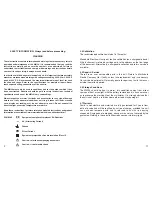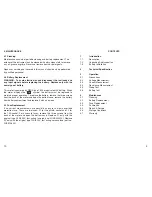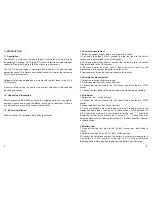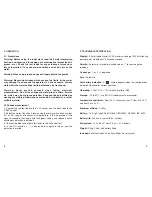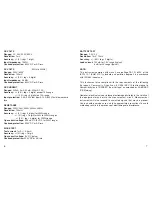
3.3 Current measurement
1. Select the correct current range, using the rotary switch.
2. For inputs less than 200mA, connect the red test lead to the uA/mA
socket, and the black lead to the COM socket.
3. For inputs greater than 200mA, connect the red lead to the 10A socket,
& the black lead to the COM socket.
4. Remove power from the circuit, open the circuit path for the
measurement and connect the meter in series with it.
5 Apply power and take the reading shown on the display.
3.4 Resistance measurement
1. Select the required resistance range.
2. Remove power from the circuit under test.
3. Connect the red test lead to the "V
Ω
" socket and black lead to "COM"
socket.
4. Connect the test leads to the measurement points and take a reading.
3.5 Diode test
1. Select the " " switch position.
2. Connect the red test lead to the "V
Ω
" socket and black lead to "COM"
socket.
3. Remove power from the circuit under test.
4. Touch the probes across the diode and take a reading, reverse the
probes and again take a reading. For a silicon diode, a value between 0.5
& 0.6 should be obtained in the forward direction, and "1." should be
displayed for the reverse direction. A value of "1." in both directions
indicates open circuit, a reading lower than 0.5 in either direction indicates
a shorted diode.
3.6 Battery test
1. Connect the red test lead to the "µA/mA" socket and black lead to
"COM".
2. Select either the 1.5V or the 9V "Batt" switch position.
3. Connect the test probes across the battery, a satisfactory reading for a
1.5V battery is >1.25V, and for a 9V battery is > 8.1V. Further information
regarding battery life may be obtained from the battery manufacturer.
1. INTRODUCTION
1.1 Description
The MM34 is a general purpose digital multimeter having average
responding AC voltage, DC voltage, DC current & resistance measurement
capability. Diode test & battery test functions are also present.
The 10A DC current range is separately fused, and has it's own test lead
connection socket. A different connection socket is used for the remaining
DC current measurements.
Voltage and resistance readings are made with the test leads in the V
Ω
&
COM sockets.
A central rotary switch is used for the manual selection of the required
function, and range.
1.2 Unpacking & Inspection
Before unpacking the MM34, examine the shipping carton for any sign of
damage. Unpack and inspect the MM34 for any sign of damage. If there is
any damage then consult the supplier immediately.
1.3 Battery Installation
Refer to section 4.2 for battery installation instructions.
4
9


